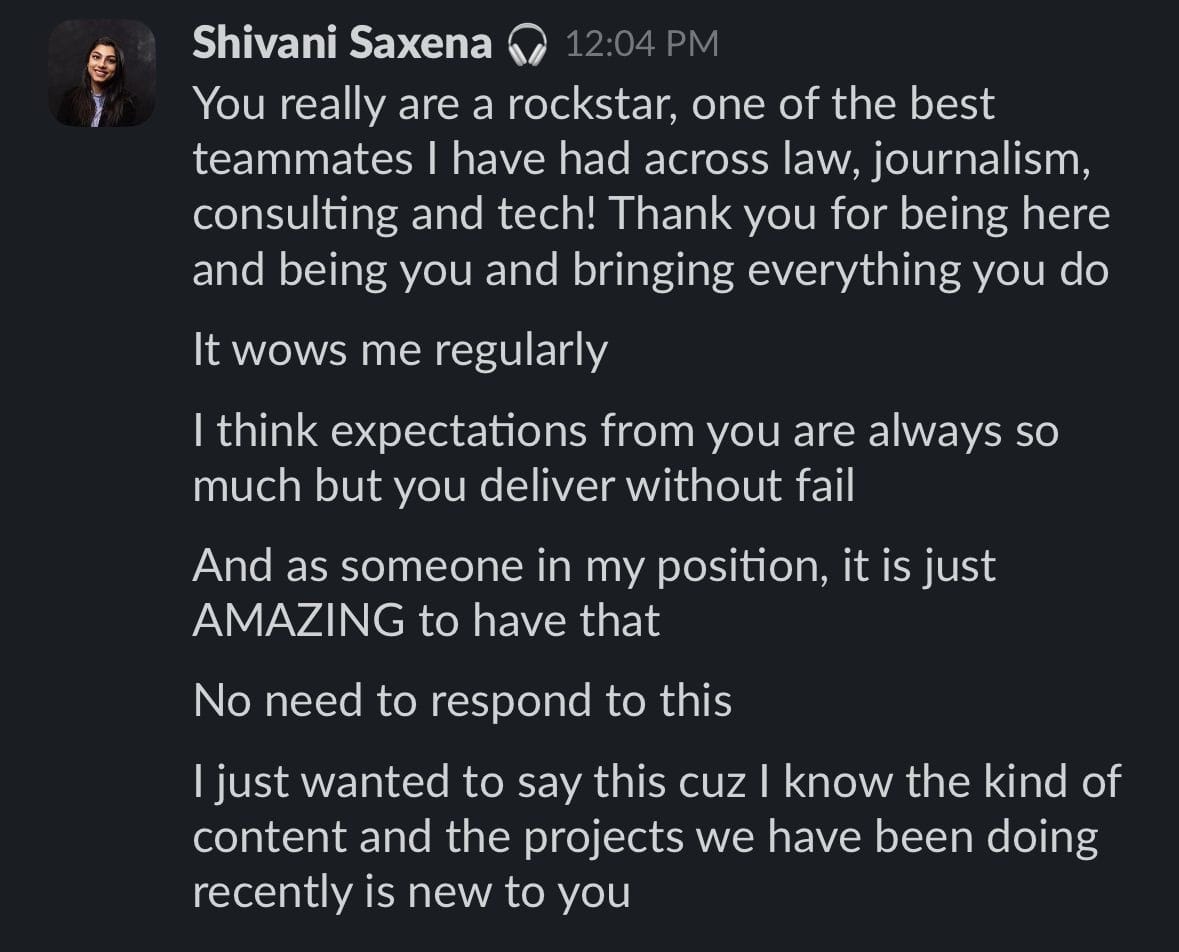When I joined RemotePass, my role looked simple enough: manage the blog, run social media, and handle some PR. Standard content marketing stuff.
Three months in, that plan went out the window.
We announced a major partnership with Certn, a background screening company, and with no Head of Marketing in place, I led the go-to-market launch — aligning teams, building collateral, and ensuring the story landed. Shortly after, I inherited the entire product launch process, managing everything from Local Payroll to Ask AI end-to-end.
That’s when content marketing turned into full-scale product marketing.
Like most PMMs, I was juggling multiple priorities, limited resources, and constant. Yet, I did it without burning out, even receiving great feedback from a C-suite exec:

Now, I know you’re probably wondering how I pulled that off. The short answer is: you don’t ‘hustle’ your way through it; you systemize.
Here are the seven frameworks that helped me stay organized, effective, and (mostly) sane while coordinating more than 15 launches.
Systemize before you scale
Although I ‘aced’ my first three launches, I was utterly exhausted and all over the place by the time the confetti settled. This was mainly because I was reinventing the wheel for the GTM brief every single time.
So before my fourth launch, I templatized our entire marketing brief, creating a single, easy-to-plug-and-play plan format that codified our process. I even used an AI tool to accelerate the initial draft research and quickly refine the structure.
This simple system eliminated the time spent ideating new marketing briefs from scratch and reduced friction with other teams.
On top of that, marketing stopped being a blocker and became an accelerator. We were consistently the fastest team when it came to GTM launch deliverables, allowing the focus to shift from ‘What do we need?’ to ‘How do we make this better?’
Align with product early
When you’re sprinting through launches at a fast-moving startup, it’s alarmingly easy for Marketing and Product to fall out of sync. To move past this blocker, we established:
- A shared roadmap view: We created a live roadmap dashboard showing every upcoming feature.
- Launch criteria: We collaboratively agreed on a criteria for each launch — was it an awareness-heavy GTM that required a full-scale campaign, or a lightweight, integrated update? This managed team bandwidth and expectation.
- Defined cadence: We established a clear cadence for when to kickstart GTM planning. For instance, with a major item like Local Payroll, we started planning and getting the product brief a full two weeks before the feature was scheduled for deployment.
This forward planning helped us manage expectations better and ensured we could go to market quickly and confidently. Sure, there were times Marketing was ready and Product wasn’t quite done, meaning we had to postpone going live.
But even then, those ‘finished-and-reviewed’ marketing assets were simply put on ice, ready to ‘defrost’ the minute the product lead gave the all-clear.
Turn cross-briefing into a launch ritual
Once you’ve aligned the GTM brief with Product, your next task is to secure buy-in and readiness from everyone else who faces the customer or executes the assets.
For me, this meant setting up calls with the core teams who would execute and sell the release. This included Sales (the frontline revenue generators), the web developer (who owns the landing page implementation), the designer (who creates all the visual assets), and our Arabic translator (crucial for localizing our assets for our Middle Eastern customers).
This cross-briefing ensured everyone was carried along and, more importantly, armed with the information they needed to do their work without confusion.
Build enablement, not just excitement
It’s true that PMM and Sales alignment can be tough. As Product Marketing Lead, Rafey Iqbal Rahman once pointed out in the PMA Slack community, misalignment often stems from Sales talking to CIOs while Marketing focuses on champion users, creating a huge chasm in messaging.
But I’m proud to say that during my tenure, the Marketing and Sales teams at RemotePass collaborated seamlessly, and a major factor was proactive enablement.

First, the cross-briefing helped (Lesson 3!), then I took it a step further. For example, during the Ask AI launch, our most recent and complex release, I created:
- Sales one-pagers and slides: These were simple, clean assets that they could easily attach to an email or present quickly during a demo call, focusing on the high-level business value, not just the features.
- Social media angle guides: I created a brief document for the Sales team containing specific angles and compliant messaging they could leverage to promote the release on their own social channels.
This made it easy for them to promote the feature in a way that was aligned with our central message, without resorting to overly ‘salesy’ language.
Make it easy for the C-suite to sign off
During my first few GTMs, C-suite approval was a major blocker. It took days for stakeholders like the CEO to review marketing assets, and often, those reviews culminated in a flurry of major edits dropped right at the eleventh hour.
The issue, I eventually realized, was my approach. I hadn’t structured reviews for speed or clarity, so exec feedback came late.
I solved this by adding an ‘executive sign-off checkpoint’ into our launch rhythm, scheduled consistently one week before the live date. All C-suite had to do was review a brief, focused summary covering:
|
Section |
Key question |
Deliverable (Max 2 sentences) |
|
Strategic goal |
What is the singular, measurable business outcome? |
Example: Drive 15% increase in MoM usage among mid-market customers in APAC. |
|
Core positioning |
What is the one-sentence takeaway and the key customer pain point solved? |
Example: We help customers [solve pain point] by [unique solution]. |
|
Risk/Alignment check |
What is the main risk, and which teams are aligned? |
Example: Risk is low CS adoption; mitigated by mandatory enablement sessions on Tuesday. |
|
Launch sequence |
What is the main date and the key content vehicles? |
Example: Going live next Monday; main vehicles are webinar and sales enablement assets. |
Don’t let the buzz die after launch
Beyoncé once famously critiqued artists who ‘just release a bunch of work until they burn out.’ While she was talking about the music industry, that same critique applies perfectly to how many startups approach GTM launches. They drop a feature, make a major announcement, and then immediately move on to the next shiny object.
Even at RemotePass, we weren’t safe from this bug. Our Customer Success (CS) team was learning that many users were completely unaware of recently released or updated features. We were failing the final mile, putting effort into the sprint but neglecting the marathon.
We changed the tide by implementing a culture of creating assets that sustain the hype long after launch day. This sustenance was a deliberate content sequence of social posts, articles, and emails designed to drive deeper engagement and stickiness.
For major products, we amplified this into a full-on campaign. For example, after the initial launch of Contractor of Record, we followed up the usual social and email sustenance with in-depth blog posts and a dedicated eBook to educate and nurture warm leads. This approach ensured we stayed top-of-mind and maintained momentum even long after the launch day high.
Conduct post-mortems that lead somewhere
After every launch at RemotePass, I made it a rule to circle back and review what actually happened. We’d track adoption, engagement, and sales enablement usage to see where the story landed and where it fell flat.
But the real breakthroughs came when we connected those numbers with what customers were saying. Using CRM data, I noticed a recurring note from Sales calls: several prospects thought RemotePass offered recruitment services.
That single insight changed how we framed future messaging. We created a blog post and social content clarifying what our Employer of Record (EOR) service really provides, and lead-to-SQL conversion improved by roughly 25% within a month
Those are the kinds of findings a good post-mortem delivers – not just numbers, but context that shapes the next launch. When reflection becomes part of your rhythm, every GTM gets a little sharper than the one before.
Rhythm over hustle
After 15 launches, I learned that the secret to scalable, effective GTM is rhythm. Once you find yours, where systems are automated and teams are aligned, even the busiest calendar feels lighter. You stop firefighting and start leading.
If you’re leading GTMs right now and trying to stay sane, I’d love to hear: what’s one system that helps you maintain your rhythm?



